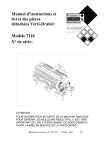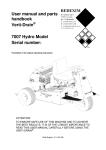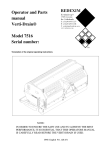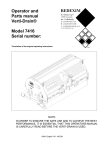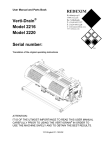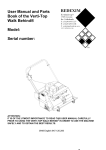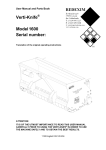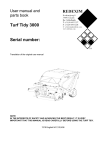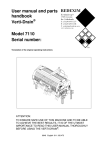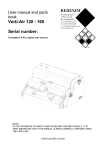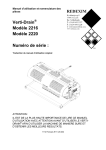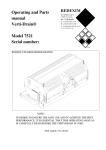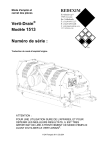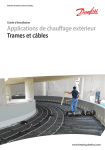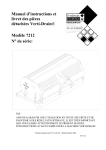Download Verti-Drain 7626 - Charterhouse Turf Machinery
Transcript
Operator and Parts manual Verti-Drain® Model 7626 Serial number: Translation of the original operating instructions NOTE: IN ORDER TO ENSURE THE SAFE USE AND TO ACHIEVE THE BEST PERFORMANCE, IT IS ESSENTIAL THAT THIS OPERATORS MANUAL IS CAREFULLY READ BEFORE THE VERTI-DRAIN® IS USED. 0948 English 911.120.472 FOREWORD Congratulations on your purchase of the Verti-Drain®. To ensure the long and safe use of ® this Verti-Drain , it is of the utmost importance for all those who will be using it to read and understand this user manual. Without full knowledge of the content, operation of this machine is not safe. ® The Verti-Drain is not an independently operating machine. The user is responsible for ® using the appropriate tractor. The user must also check the tractor/Verti-Drain combination for safety aspects such as the noise level, adequate user instructions, and possible risk factors. ® The Verti-Drain is solely intended for use on lawns and other areas where grass could grow. On the next page you will first find the general safety instructions. Every user must know and be able to apply them. After this, a registration card is included. This card should be returned in order to be able to handle any future claims. This user manual offers many instructions numbered in sequence. This sequence should be observed. An asterisk * indicates a safety instruction. An @ indicates a tip and/or note. All information and technical specifications provided at the moment that this document is published are the most recent ones. Design specifications may be changed without prior notice. This document is a translation of the original operating instructions. Upon request, the original operating instructions are available in Dutch. WARRANTY CONDITIONS ® THIS VERTI-DRAIN IS DELIVERED WITH A WARRANTY AGAINST DEFECTS IN MATERIALS. THIS WARRANTY IS VALID FOR A PERIOD OF 12 MONTHS FROM THE PURCHASING DATE. VERTI-DRAIN® WARRANTIES ARE SUBJECT TO THE “GENERAL CONDITIONS FOR SUPPLY OF PLANT AND MACHINERY FOR EXPORT, NUMBER 188”, WHICH ARE PUBLISHED UNDER THE AUSPICES OF THE UNITED NATIONS ECONOMIC COMMISSION FOR EUROPE. REGISTRATION CARD For your own information, please complete the table below: Serial number machine Dealer name Date of purchase Remarks 2 ! SAFETY INSTRUCTIONS ! The design of the Verti-Drain® allows for safe use. However, this is only possible if the user completely follows the safety instructions given in this manual. Read and understand (Fig. 1) the manual before beginning to use the Verti-Drain®. If the machine is not used as described in the manual, injury and/or damage to the Verti-Drain® may result. Fig. 1 ® (1) The Verti-Drain is solely intended for the treatment of lawns or other areas where grass should grow. Any other use is considered to be incorrect use. The manufacturer accepts no liability whatsoever with regard to damage resulting from such incorrect use; all resulting risks are the responsibility of the user. Correct use also includes following the manufacturer’s usage, maintenance and repair instructions. Before using the Verti-Drain®, inspect the area to be treated. Remove any loose obstacles and avoid irregularities. ® (2) The Verti-Drain was constructed according to the latest technological knowledge and is safe to use. Improper use, maintenance or repair of the machine may result in injury to both the user and others. This should be avoided! Always use the Verti-Drain® in combination with the proper tractor as described in the technical data. (3) All persons whom the owner assigns to operate, maintain or repair the VertiDrain® must read and have completely understood the operating manual and in particular the section Safety Instructions. The user is responsible for a safe tractor/ Verti Drain® combination. This entire unit must be tested in terms of noise, safety, and ease-of-use. In addition, user’s instructions must be prepared. ® (4) Before using the Verti-Drain , the user is obliged to inspect it in terms of visible damage and defects. Any changes in the Verti-Drain® (including its functioning) that may affect its safety must be corrected immediately. For reasons of safety, it ® is in principle forbidden to make changes in or additions to the Verti-Drain (with the exception of those approved by the manufacturer). If any modifications have been made to the Verti-Drain®, the present CE certificate becomes null and void and the person who made the modifications should himself make sure a new CE certificate is granted. 3 Before each use, inspect the Verti-Drain® for loose bolts/nuts/parts. If present, inspect the hydraulic hoses regularly and replace these if they are damaged or show signs of wear. The replacement hoses must meet the manufacturer’s technical specifications. Always relieve the pressure from the hydraulic installation, if present, before carrying out any work on it. NEVER use de Verti-Drain® if its protective covers and safety decals are missing. NEVER crawl underneath the Verti-Drain®. If you need to access the bottom, tilt the Verti-Drain®. NEVER step off the tractor while the engine is still running. When carrying out maintenance, adjustments or repairs, make sure the VertiDrain® is blocked from sagging/moving/sliding. Before carrying out any maintenance, adjustments or repairs, always switch off the tractor engine first, remove the tractor key from the ignition, and disconnect the PTO (Fig. 2). Fig. 2 When carrying out any maintenance or repairs, make sure to use original VertiDrain® parts only. This will ensure continued safety of the machine and its user. Only authorised technical personnel may carry out adjustments and repair work to the Verti-Drain®. Keep an overview of repairs. (5) In addition to the instructions in this user manual, the generally applicable regulations with respect to safety and working conditions must be followed. For use on public roads the relevant guidelines of the Highway Code also apply. Transporting persons is not permitted! Do not use the Verti-Drain® when it is dark, during heavy rain/ storms, or on slopes with a gradient greater than 20 degrees. 4 (6) Before starting to work, all persons who will operate the Verti-Drain® must be familiar with all its functions and controls. Connect the Verti-Drain® to the vehicle that will pull it exactly according to the instructions (Danger of injury!) Before driving off, make sure you have a clear view both nearby and far away. ® On both sides of the Verti-Drain , decals (Fig. 3,4,5) are applied to the sideboard (Fig. 6) showing these warnings. Make sure these safety decals are always clearly visible and legible. Replace them if they are damaged. During operation, make sure there are NO persons in the danger area of the Verti-Drain®, because they may be injured by moving parts. (Fig. 3) Fig. 4 Fig. 3 Remain at least 4 metres away! (Fig. 4) The back cover must always be closed and undamaged during operation of the machine! (Fig. 5) Be careful not to get pinched when opening the rear cover! (Fig. 6) Fig. 5 Fig. 6 Be aware of the maximum lifting capacity of the towing vehicle. Wear suitable clothing. Wear sturdy shoes with a steel tip, wear long trousers, do up long hair and wear no loose clothing. 5 (7) Location of safety stickers. (Fig. 7) Fig. 7 Used oil/grease is harmful to the environment; dispose of it according to locally applicable regulations. 6 CONTENTS Section Description Page Foreword 2 Warranty conditions 2 Registration card 2 Safety instructions 3 1.0 Technical data 8 2.0 First installation, removing the machine from the pallet 9 3.0 General parts list 10 4.0 The power take-off shaft 11 4.1 The length of the power take-off shaft 11 4.2 Use of the power take-off shaft 12 4.3 Slip coupling information and maintenance 12 5.0 Adjusting the operating depth 13 6.0 Pin angle adjustment 13 7.0 Driving speed 14 8.0 Start procedure 9.0 10.0 15 ® Operation of the Verti-Drain 16 ® Transportation of the Verti-Drain ® 16 11.0 Disconnecting the Verti-Drain 16 12.0 Troubleshooting 17 13.0 Maintenance 18 14.0 EU certificate 20 15.0 Technical information 21 15.1 Torque values 21 15.2 The crankshaft 22 15.2.1 Replacement of an oil catcher 22 15.2.2 Replacement of a crank throw / crank bearing 22 15.2.3 Releasing crankshaft tension 23 15.3 Aligning an element 23 16.0 Option, Turf hold-down kit 24 16.1 Option, pins 25 16.1.1 Solid pins 25 16.1.2 Hollow pins 26 Parts pages 7 1.0 TECHNICAL DATA Model 7626 Operating width 2.60 m (102”) Operating depth Up to 400 mm (16”) Tractor speed measured at 500 rpm PTO-shaft speed Hole separation 65 mm (2-1/2”) Hole separation 130 mm (5”) Hole separation 195 mm (7-1/2”) PTO-shaft speed: (max.) Up to 0.75 km/hr (0.47 mph) Up to 1.50 km/hr (0.93 mph) Up to 2.25 km/hr (1.40 mph) Up to 500 rpm Weight 1930 kg (4254 lbs) Hole separation between the pins 129 mm (5”) with 24 mm (1”) holes 65 mm (2.5”) with 12 mm (1/2”) holes Hole separation in driving 50 – 195 mm ( 2 - 7 1/2”) direction Recommended tractor 65 HP with minimum lifting capacity of 2300 kg (5070 lbs) Double-acting external hydraulic connection. Maximum capacity Hole separation 65 mm (2-1/2”) Hole separation 130 mm (5”) Hole separation 165 mm (6-1/2”) Shipping dimensions Up to 1950 m²/hr (20989 ft²/hr) Up to 3900 m²/hr (41979 ft²/hr) Up to 5850 m²/hr (62969 ft²/hr) 2800 x 1100 x 1560 mm (110” x 43.3” x 61.4”) Maximum pin size Slip coupling, gearbox Solid 24 x 400 mm (1”x 16”) Hollow 32 x 300 mm (1-1/4”x 12”) Maximum 1100 Nm (9680 lb.inch.) Three-point connection 3- point CAT 2 Gearbox oil SAE 140 Lubricant EP 2 Standard parts Set of solid pins 18/400 (3/4” x 16”) Front and back roller. 3-speed gearbox. Tool tube with tools. Hydraulic adjustment of the operating depth. PTO shaft. 8 7626 Verti-Dra 7626 Verti-Drain Ve rt 7 6 i-Dr 26 a R Detail A PTO−cover Lock Hole Hole 4 R Verti-Drain 7626 Pin 3 Fig. 8 2.0 FIRST INSTALLATION, REMOVING THE MACHINE FROM THE PALLET The machine is standing vertically on the pallet. To remove the pallet and lay the machine horizontally, carry out the following steps (see fig. 8): 1. Open the rear cover 2. Fasten a cable to the lifting point * Make sure that the cable/crane/lift can lift at least 2500 kg (5512 lbs) 3. Raise the machine, including the pallet, 50 mm from the ground. 4. Remove the pallet by sliding it over the bottom 3-point pins * Do not crawl under the machine!! 5. Lower the machine slowly until the 3-point connection plates touch the ground. 6. Lower the machine further so it can run on the front roller 7. Continue to lower the machine until it rests on the front and rear rollers. 8. Install the included PTO cover. 9. Attach the machine to a tractor. * Use the correct tractor. See the specifications. 10. Connect the hydraulic hoses to the tractor. 11. Raise the machine off the ground. 12. Open the valve on the right-front side of the machine (Detail A) by turning it anticlockwise (with the included key) to purge the hydraulic operating-depth adjustment system of air. 13. Activate the hydraulic output of the tractor, and carefully lower the roller to remove the air from the system. 14. Close the valve of the right-front side of the machine (Detail A) by turning it clockwise (with the included key). When the system still contains air repeat point 13 and 14 to remove this. The system is now free of air and ready for use. 15. Remove the locking pins for the rear roller. Put pins 3 in hole 4. 16. Lower the machine to the ground, and turn the top rod to adjust the angle of the machine to 90 degrees. @ this angle of 90 degrees is very important for the correct operation of the machine. 17. Set the tractor’s stabiliser to 100 mm lateral movement. 18. Mount the pins. Grease the end that will be inserted. 19. Length of the PTO shaft, see 3.1. 9 Fig. 9 3.0 GENERAL PARTS LIST Figure 9 shows a number of important parts: 1. Safety decal RA, read user manual before use / Toolbox with tools and manual. 2. Safety decal 911.280.402, keep a distance of at least 4 metres from the machine. Stop the engine before carrying out repairs or adjustments. 3. Safety decal 911.280.404, the back cover must always be closed and undamaged during operation of the machine! 4. Safety decal 900.280.404, Be careful not to get pinched when opening the rear cover! * Make sure all decals are clearly visible on the machine and are understood. 5. The serial number is on the inside of the machine. 6. Hydraulic adjustment of the operating depth. 7. Operating-depth indicator. Attention: the indication is based on the maximum length of the pins. 8. Pin angle adjustment spindles. 9. Rubber stops for support of the rear cover in the opened position. 10. Support guide for the rear roller. 11. Locking pin for the rear roller. Lock only when the machine is not in use or when the roller is lifted from the ground with hollow pins. 12. 3-point fastening. 13. PTO protective covers on the machine. 14. PTO input shaft. Slip coupling must be attached to this shaft. 15. Adjustable back-roller scraper. 16. Star button/nut for securing the back cover of the Verti-Drain®. 17. Hydraulic connection to towing vehicle. 18. Pin angle adjustment indicator. 19. Air-purge valve for hydraulic operating-depth adjustment. 10 4.0 The PTO shaft The PTO shaft is a very important part. It provides the driving force from the tractor and – if installed, used, and maintained correctly – ensures safe use of the machine. The PTO shaft has its own CE certificate. Make sure to read the PTO shaft manual. It is located on the PTO shaft itself. Fig. 10 4.1 LENGTH OF THE PTO SHAFT The length of the PTO shaft is very important. If it is too long, it may damage the drive of the tractor and/or the Verti-Drain®. If the overlapping length of the sleeves is, at any time, shorter than 150 mm, the PTO shaft may be damaged. *The length will vary when the machine is raised or if another tractor is used. To make sure the length of the PTO shaft is correct, after purchase or when using another tractor, carry out the following steps: (see Fig.10) 1. Measure the distance between the PTO connection of the tractor and that of the VertiDrain, from groove to groove, when the machine is at the correct angle on the ground and attached to the tractor. 2. Measure the distance B of the PTO at its shortest position, from locking pin to locking bolt. 3. Split the PTO in two and remove the protective cover from both ends. 4. Both the sleeve ends and the cover ends have to be shortened: (B-A) + 75 mm (3”). 5. Debur, grease, and assemble all parts. 6. Attach the PTO with the slip-connection side facing the Verti-Drain. *The torque of the locking bolt must be 80 Nm (9700 lb.in.) and must be checked every 40 hours. 7. Attach the other end of the PTO to the tractor. 8. Check the overlap of the sleeves. *Never use the machine if the protective cover of the PTO is damaged. Replace it first. 11 4.2 OPERATION OF THE PTO SHAFT To ensure correct operation of the PTO, check the following items: 1. During operation, the angle of the joints must never be greater than 30 degrees. 2. The rotating points should be aligned. 3. The overlap of the sleeves must be at least 150 mm. 4. Never use the machine if the protective cover of the PTO is damaged. 5. For lubrication, see section 13.0: Maintenance. 4.3 SLIP COUPLING INFORMATION AND MAINTENANCE The slip coupling will protect your machine from damager if used and maintained properly. The following items are important: 1. The length of the spring is normally adjusted to 33 mm (1.300”). 2. When the slip coupling slips, the bolts/nuts may be turned a quarter turn at a time until the minimum spring length of 31.5 mm (1.250”) has been reached. Further compression will overload the machine. @ When the bolts/nuts are over-tightened, the machine will eventually be damaged or dangerous situations can occur. 3. The slip coupling must be receive monthly maintenance. Do this as follows: - - Remove the upper PTO cover from the machine. Loosen all bolts/nuts 2 turns. Run the machine in the field at a very low speed. If the coupling slips, stop after 10 seconds. If the coupling does not slip, loosen the bolts further or proceed to the (annual) maintenance. (see point 4 below). Once the coupling has slipped, retighten all the bolts/nuts to the point at which the slip coupling functions properly again. * Do not immediately retighten it to the previous setting. 4. Annual maintenance: - Remove the PTO from the machine. - Carefully check all parts of the PTO. - Replace all parts that are damaged. - Disassemble the slip coupling by removing all the bolts/nuts that hold the springs together; this should cause the slip coupling to fall apart. - Lay out all the parts and check them carefully. If any parts are damaged or worn, replace them. - Clean all parts that interlock or engage. - Reassemble all the parts and tighten the bolts and nuts until the springs are adjusted to 33 mm (1.3”). - Grease both sleeves and reassemble the two PTO halves. - Reassemble the PTO and mount it on the machine. - If necessary, adjust the springs of the slip coupling as described previously. @ The slip coupling protects the machine from short-duration overloading, if properly adjusted. Long-duration overloading will damage the machine. The slip coupling provides no protection for this. Do not overload your machine. 12 Fig. 11 Fig. 12 5.0 OPERATING-DEPTH ADJUSTMENT The operating depth can be adjusted when the machine is raised (before start of use) or during operation in the ground when the machine is in use, see fig. 11. The machine is equipped with a hydraulic operating-depth adjustment that can be operated from the tractor by activating the hydraulic output of the tractor. The label (1) on the side of the machine indicates the depth setting. @ Make sure that both sides of the machine raise or lower evenly. If not, stop the movement immediately to prevent damage to the machine. To remove trapped air from the hydraulic operating-depth adjustment, see chapter 2.0 points 12 through 14. @ The depth-adjustment on the decals only applies when 400 mm (16”) long pins are used. When shorter pins are used, subtract the difference in length, compared to 400 mm (16”), from the value shown on the decals. 6.0 PIN ANGLE ADJUSTMENT All pins can simultaneously be adjusted with 2 handles, one of which is located on the front of the machine; see fig. 12. Lift the machine above the ground and loosen counter nut 2 on both sides of the machine. Adjust the angle by turning the handle 3. The angle can be read on indicator 4. Then retighten counter nut 2. @ An angle of 90 degrees means almost no draught. This is required for hollow pins and is advised for the 8 mm (5/16”) pins. @ From 90 to 65 degrees means more draught. This is advised for solid pins and is dependent of the ground conditions, the pin size and the client’s preference. @ At 90 degrees, the pins only go straight into the ground if the machine is correctly installed, see fig. 8. If this is not correct, force F can be produced, see fig. 12, which will damage the machine. @ The length of the assembled drawbar must be 595 mm (23.4”), which can be calibrated using shims. (see parts page) 13 Fig. 13 7.0 DRIVING SPEED The hole distance D, fig. 13, in the driving direction is determined by the drive speed. The Verti-Drain® does not require creep gear. If the client wants a small hole distance, however, it must be possible to ride slowly enough, which depends on the tractor. The gearbox has three positions: 1, 2 and 3. The higher the number, the faster the crankshaft turns. The input speed of the PTO shaft R may not exceed 500 rpm. If hard objects can be expected, this speed must be reduced. With heavier pins, other applications, or with maximum pin angle, the pin holders may float. In this case, reduce the speed R before the pin holders are forced upward. In fig. 13 is a table that shows the relationship between the driving speed, the gearbox speed and the hole distance. If the driving speed of the tractor for 500 revolutions of the PTO shaft is known, the hole distance can be determined for the different gears. ® @ If the Verti-Drain is not correctly attached behind the tractor, see fig. 8, various PTO shaft angles can cause vibrations in the driveline of the machine. These vibrations can damage the machine and the holes in the ground. @ If changing gears is difficult, the crankshaft should be turned a little. @ If the PTO shaft was shortened incorrectly, or if another tractor was used, the gearbox may be overloaded. Damage can occur. * If the gearbox is shifted, the tractor motor must be shut off and the tractor / Verti-Drain® combination must be blocked to prevent it from driving/rolling away. 14 Fig. 14 8.0 START PROCEDURE The start procedure is VERY important. If this procedure is not followed exactly as described below, serious damage may occur to the machine. The start procedure is as follows, see fig. 14. 1. 2. 3. 4. 5. 6. Ride to the area where you want to begin. Lower the machine until the lowest knives are almost touching the ground. Set the tractor motor at approximately 1200 rpm. Shift the tractor to the correct gear and drive forward (A). Engage the PTO shaft (B). While DRIVING forward, let the TURNING machine CAREFULLY sink into the ground (C). 7. Increase the PTO shaft speed to the maximum allowable speed. Stopping is done as follows: 1. Decrease the motor speed to approximately 1200 rpm. 2. Raise the machine out of the ground (with the hydraulic depth adjustment or with the lifting device of the tractor). 3. Disengage the PTO shaft as soon as the pins are out of the ground. 4. Raise the machine further until the pins are at least 120 mm above the ground. 5. Go to the following location and begin again as described. @ It is absolutely imperative that the above procedures are followed. If the placed in the ground first, without a rotating PTO shaft, serious machine can occur. @ The machine must be lowered CAREFULLY. @ Be careful when driving in reverse. machine is damage to the While working, the front roller must be in stable contact with the ground. If the machine is unstable, other pins must be installed or the operating depth must be adjusted. @ The machine will be damaged if the instability is not corrected. The machine does NOT have protection against long-duration overloading. @ NEVER drive in reverse with the pins in, or close to, the ground. @ Do not use a hydraulic top rod. 15 9.0 OPERATION OF THE VERTI-DRAIN® Before the Verti-Drain® is used in the field, the following should be checked: 1. Are there any loose objects in the field? Remove these first. 2. Are there any slopes? The maximum slope that can be worked with this machine is 20 degrees. Always move downhill. 3. Does the ground contain cables or pipes? If so, determine their depth and set the operating depth of the machine to 60% of this depth. ® 4. Does the ground contain hard objects? If so, use the Verti-Drain at a low PTO shaft speed and adjust the operating depth. 5. Is there any danger of flying objects, such as golf balls, which may distract the attention ® of the driver? If so, do NOT use the Verti-Drain . ® 6. Is there any danger of sagging or sliding? If so, postpone working with the Verti-Drain . 7. If the soil is frozen or very wet, the treatment should be postponed until the circumstances are more favourable. 8. When the soil is very compact, use shorter pins or adjust the operating depth. 10.0 TRANSPORT OF THE VERTI-DRAIN® The user is responsible for the transport of the Verti-Drain® behind the tractor when travelling on public roads. Check the national traffic regulations. On open fields, a maximum speed of 12 km/h (8 mph) should be observed, because of the weight of the Verti-Drain®. A higher speed may endanger the driver and/or other people and may even damage the machine. * When the machine is in the raised position, at least 20% of the weight of the tractor should be supported by the front axle. 11.0 DISCONNECTING THE VERTI-DRAIN® The machine can be disconnected from the tractor as follows: 1. Open the rear cover. 2. Turn the crankshaft until both central pin holders right/left of the gearbox are in their top positions. 3. Fold up all the other pin holders. 4. Set the machine with both rollers on solid ground. 5. Lock the rear guide with pin 3, see fig. 8. 6. Block the front and rear rollers from rolling away. 7. Remove the top rod. 8. Remove the PTO shaft on the tractor side. 9. Remove the lower arms of the tractor from the Verti-Drain®. * Set the tractor motor off if people are walking around the machine and prevent the tractor from moving! * When storing the machine for a long period, it is recommended NOT to fold up the pins in view of the life span of the of the shock-absorber springs. 16 12.0 TROUBLESHOOTING Problem Machine vibrates. Possible cause Crankshaft turns irregularly Heavy conditions Solid/hollow pins bend/break. Wrong pin Heavy conditions Rapid wear Front roller is not in stable contact with the ground. Wrong pins, too much resistance Heavy conditions PTO breaks. Slip coupling breaks often Tubes split Damage to the drawbars. Bend / break Damage to the turf. Oval holes Damage to the turf Pin not secure in pin holder. Heavy conditions Solution Machine not at 90 degrees. Angles of the PTO joints are different. Joints of PTO are not in line. Adjust the operating depth. Use thinner/shorter pins. If conditions are dry, water soil. Change the pin, use shorter pin. Use solid pins before hollow pins to break up the ground. Adjust the operating depth. Use thinner/shorter pins. If conditions are dry, water soil. First use solid pins to break open the ground. Adjust the pin angle. Change pin size. Adjust the operating depth accordingly. Use different pin size. Adjust the operating depth. Water the soil. Do not do all the work at one time. Check adjustment. Replace friction plates. Clean the inside of the coupling. PTO angles are too large. PTO angles are not the same. Machine not at 90 degrees. Centre bar bent. Bearing tubes worn. Pins touch the ground when driving in reverse. Lift height not correct. Ground too wet. Change pin angle adjustment. Reduce forward speed. Adjust the operating depth. Use thinner pins. Use different pins. Grind a flat area on the pins. Adjust the pin angle. 17 Crankshaft problems. Big-end nuts come loose Eliminate the vibration, see vibration. Crankshaft bearing worn. Incorrectly installed after repair. Remove, clean, use Loctite. Rear roller vibrates. Rear roller locked Rear roller is raised when pricking with hollow pins Unlock it. Change the rotational speed of the PTO. Set roller freely on the ground. Change the machine adjustments. Heavy conditions Front roller does not lower properly or evenly. Air in hydraulic operatingdepth system Bleed air from the hydraulic operating-depth system. (See chapter 2.0 points 12 through 14) 13.0 MAINTENANCE Time schedule Before each use Check point / lubricating point Method Check for loose bolts/nuts. Tighten the loose bolts/nuts with the correct torque. Connect the machine to the tractor and leave the machine running without load for five minutes. Look and listen for any strange noises and movements. Check the oil level in the Use SAE 140. gearbox. The oil level should be at the centre of the gauge glass. Check the hydraulic components Repair any leaks/damage. for leaks/damage. Presence and legibility of safety decals. (Fig. 7). Replace these if damaged or missing. Any loose parts around the PTO. Secure these parts so that they cannot come too close to the PTO. 18 Time schedule After first 20 operating hours (new or repaired) Check point / lubricating point Method Lubricate the PTO, roller bearings and crankshaft bearings. Use EP 2 lubricating grease. Check for loose bolts/nuts. Tighten the loose bolts/nuts with the correct torque. Connect the machine to the tractor and leave the machine running without load for five minutes. Look and listen for any strange noises and movements. Use SAE 140. Check the oil level in the gearbox. The oil level should be at the centre of the gauge glass. Check the hydraulic components Repair any leaks/damage. for leaks/damage. After every 50 operating hours. Check the transmission for oil leaks. Replace seals / sealing paste. Any loose parts around the PTO. Secure these parts so that they cannot come too close to the PTO. Use EP 2 lubricating grease. Lubricate the PTO, roller bearings and crankshaft bearings. Check for loose bolts/nuts. Tighten the loose bolts/nuts with the correct torque. Connect the machine to the tractor and leave the machine running without load for five minutes. Look and listen for any strange noises and movements. Replace the oil in the gearbox. Use SAE 140. Check the hydraulic components Repair any leaks/damage. for leaks/damage. After every 500 operating hours. Check the transmission for oil leaks. Replace seals / sealing paste. Replace the oil in the gearbox. Use SAE 140. 19 14.0 EU DECLARATION OF CONFORMITY We, Redexim, Utrechtseweg 127, 3702 AC Zeist, The Netherlands, declare entirely on our own responsibility that the product: ® VERTI-DRAIN MODEL 7626, WITH MACHINE NUMBER AS INDICATED ON THE MACHINE AND IN THIS MANUAL, to which this declaration relates is according to the stipulation of the 2006/42/EC directive for machines. Zeist, 01/10/09 A.C. Bos Manager Operations & Logistics Redexim Holland 20 15.0 TECHNICAL INFORMATION Generally speaking, the Verti-Drain® is not a complicated machine. A number of technical items will be explained. If you have additional questions, contact your dealer who will be happy to provide assistance. Fig. 15 15.1 TORQUE VALUES In fig. 15, the torque values for the most important bolts/nuts are shown. The bolts and nuts for which no values are given must be tightened with the same torque as similar bolts and nuts. When bolts and nuts come loose, Loctite may be used to prevent this from occurring again. Fig. 16 21 15.2 THE CRANKSHAFT The crankshaft assembly is shown in figure 16. A more detailed drawing can be found on the parts page.For a 7626, the offset between the crankshaft throws in the gearbox must be 36 degrees. 15.2.1 REPLACEMENT OF AN OIL CATCHER A top view of the crankshaft assembly is shown in figure 16. Proceed as follows to replace an oil catcher in the gearbox: 1. Remove nuts II and IV, which may be very tight if fastened with Loctite. Heat may help. 2. Remove the big-end V after the big-end pin XI has been removed. 3. Remove cap III by unscrewing all the bolts/nuts. 4. Slide throw VI from the gearbox by lightly tapping in the middle with a hammer until the big-end pin VII comes free. 5. Turn throw VI and slide big-end IX from the big-end pin VII. 6. Remove nut VIII and remove “handle” X after marking its position. 7. Remove the oil catcher with a screwdriver. 8. Clean the area / remove all oil and grease. 9. Install the new oil catcher. 10. Clean “handle” X and seal the splines with a silicone sealant. 11. Mount the “handle” in the correct position. 12. Fill the area between the “handle” and the shaft with silicone sealant. 13. Install a new lock plate and nut VIII. For the nut, also use Loctite. 14. Tighten nut VIII with the torque indicated in figure 15. 15. Install the remaining parts in reverse order. 16. If the crankshaft does not run smoothly, see 15.2.3 for additional instructions. 15.2.2. REPLACEMENT OF A CRANK THROW / CRANK BEARING Replacement of a crankshaft throw is necessary when it is cracked or when the nuts regularly come loose from the big-end. That is, if the throw bearings, the throw-bearing fittings, or the big-end pin holes in the throw are damaged. Replace the throw / the bearing as soon as possible, to prevent additional damage to other parts, as follows (see fig. 16): 1. Remove the big-end pin nuts IV (or II) from both big-end pins that are attached to the throw. 2. Remove the big-end pins so the big-end can be slid to one side (Note: this will not be possible with the big-end (pin) next to the gearbox). 3. Remove the throw-bearing caps III. 4. Tap throw IV and the bearing sideways out of the frame by striking the middle of the throw with a hammer. 5. Carefully remove the bearing from the throw. 6. After re-installing the throw and/or bearing, re-install the parts in the same order in which they were removed. Use Loctite where indicated in figure 15. 7. If the crankshaft is more difficult to turn, see 15.2.3. 22 15.2.3 Releasing crankshaft tension If parts of the crankshaft have been replaced, the crankshaft may be more difficult to turn. Pre-tension can be the cause. It is necessary to eliminate the sources of tension as follows, see fig. 16: 1. Use a hammer to tap the centre of the throw next to the gearbox, alternating between the left and right side. 2. Feel whether the throw moves in the bearing and continue until the throw settles into place. 3. Repeat this procedure for each adjacent throw until all of the throws have settled into position and the crankshaft turns more easily. @ After repairing the crankshaft, the nuts must be checked regularly for looseness, see 12.0. @ Do not mount the throws on the wrong side of the machine. See the parts page for the correct part numbers. 15.3 ALIGNING AN ELEMENT. If an element is no longer in line with the adjacent elements, the alignment can be corrected as follows: (See fig. 15) - Loosen the four bolts/nuts A, that connect the crankshaft to the element. - Loosen the two bolts B, with which the element is connected to the frame. - Try to align the element by moving it sideways until it is in line with the adjacent elements. Re-tighten all the bolts and nuts. - @ The element can be pushed out of alignment through overloading. @ Always realign an element whenever a throw is replaced so no extra tension is created in the total element assembly. @ Every pre-tension in the element assembly will reduce the life of the bearing and can also damage other parts. 23 16.0 OPTIONS, TURF HOLD-DOWN KIT. Fig. 18 You can use a turf hold-down kit when the turf layer comes loose. For the 7626, two sets are available. One with plates for the holes of 12 mm pins (part # 211.762.002) of the pin block and one with plates for the holes of 24 mm pins of the pin block. The Verti-Drain 7626 is equipped standard with a pre-mounted main beam on which the turf hold-down fingers can be mounted. The kit consists of a set of turf hold-down fingers for 12 or 24 mm pins and the mounting material consisting of a number of bolts and nuts. INSTALLATION OF THE TURF HOLD-DOWN KIT (see fig. 18): - The ordered set comes with plates 4 or 5. Mount the plates with bolt 3 and nut 2 on main beam 1. Align the plates with the pins through the slotted holes in the plates. - When the plates have been in use for some time and are bent in one direction, reverse their direction. OTHER SUGGESTIONS: - When the pins no longer sit in the middle of the machine, they may contact the sides of the slots. Re-align the pin blocks. - If the pins contact the front side of the hole (during use), check the length of the drawbar. * Never crawl under the machine. Make sure the machine is properly blocked! 24 16.1 OPTIONS, PINS Pins are essential for the correct operation of the machine. There are various pins available for this machine; see the parts page for a complete overview. In general, the pins can be divided into two categories: solid and hollow pins. We advise you to use only original pins because they are completely adapted to the machine. In fig. 12, various pin combinations are shown. The pin holders have 5 x 12 mm (½”) holes and 2 x 24 mm (1”) holes in which pins can be secured. The locking bolt A may be tightened to 40 Nm (30 lbs.ft.) and locking bolt B to 70 Nm (50 lbs.ft.) (See Fig. 19). If the pins still come out of the pin holders, grind a flat area on the mounting end of the pins. 16.1.1 SOLID PINS. Solid pins break open compacted soil. The pin angle adjustment (see section 6.0) determines the quantity of draught movement in the ground. When the angle is adjusted from 90 to 65 degrees, the draught movement increases. With a 90 degree adjustment, there is almost no pin movement created in the ground. When the pins are new, they may damage the turf, in particular when the root system is weak. First clean the pins manually or use the machine first for 10 minutes on another rough ground surface. If the root system is weak, try not to break the ground open deeper than the length of the roots. Adjust the operating depth so the prick depth is approximately 75 mm (3”) deeper than the length of the roots. This gives the roots a chance to grow deeper. Prick deeper the next time. By using this method, you can prevent damage to the turf and ensure a healthy root system. We advise you to use the solid pins with the sharp point toward the front roller. This ensures the best pin movement into the ground. On the other hand, for weak turf, we advise you to use the pins with the sharp point toward the rear roller. The rear roller must not be locked. Fig. 19 25 Always use pins with the same diameter and length. Replace a bent pin immediately. If this happens, the machine can become unstable. Do not use thicker and/or longer pins than we supply. Extra reinforcement plates are delivered standard with the machine. It is advisable to use these for solid pins to increase the lifespan of the tine holders. Shorter (ground off) pins can be used when shallower pricking is desired. Be aware that the operating depth indicated on the decal is only accurate when the maximum length of the pin is used. When oval holes are created, this means that there is a weak top layer with a hard layer underneath. Use thinner pins or wait until the (wet) top layer has dried. When top dressing must be applied, apply it before using the Verti-Drain. When the ground is difficult to prick, water the soil first, use thinner and shorter pins, or adjust the operating depth. If these measures are not taken, the machine will eventually be damaged. When large pins are used, the pin holders may be forced out of balance. If this occurs, reduce the PTO speed immediately, otherwise damage will occur when the pins contact the rear roller. 16.1.2 HOLLOW PINS The ground can be mixed with hollow pins. Various sizes are available; see the parts page for more information. The opening of the pin must be directed toward the rear of the machine. For hollow pins it is important that the pin angle is set to 90 degrees. The movement of the pin in the ground is minimal and in this manner a nice “clean” hole is made. When the pin continuously moves in the ground at an angle less than 90 degrees, the pin may eventually break. When top dressing must be applied, use the Verti-Drain first, remove the “cores” and then spread the sand. When lots of waste occurs while pricking with hollow pins, reduce the rotational speed or wet the soil first. The waste can increase the rate of wear to your machine. If the turf is damaged, first use solid pins to establish a healthy root system and then adjust the operating depth. The rear roller can be raised from the ground and locked with the locking pins so it does not flatten the cores. However, when the machine is a bit unstable and the rear roller begins to vibrate, it is better to keep the rear roller on the ground. When the hollow pins become plugged, this means that the ground is (very) compact and solid pins must be used first to break the ground open. Wetting the soil or adjusting the operating depth can also help solve this problem. 26



























